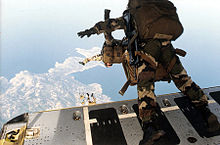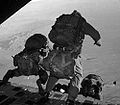- HALO jump
-
USASOC Military Free Fall Parachute Badge
HALO/HAHO
Military free-fall form of insertion.Purpose
Delivering personnel, equipment, or supplies.HALO
High-Altitude/Low-OpeningHAHO
High-Altitude/High-OpeningOrigins
Attributed to USAF
US Army Special Forces
SEAL Team SIX
and USAF Col Joe Kittinger.HALO/HAHO are acronyms that describe methods of delivering personnel, equipment, and supplies from a transport aircraft at a high altitude via free-fall parachute insertion. HALO (High Altitude-Low Opening) and HAHO (High Altitude-High Opening) are also known as Military Free Fall (MFF).
In the HALO technique, the parachutist opens his parachute at a low altitude after free-falling for a period of time, while in the HAHO technique, the parachutist opens his parachute at a high altitude just a few seconds after jumping from the aircraft. HALO techniques date back to 1960 when the U.S. Air Force was conducting experiments that followed earlier work by Colonel John Stapp in the late 1940s[1] through early 1950s on survivability factors for high-flying pilots needing to eject at high altitudes. In recent years, the HALO technique has been practiced by civilians as a form of skydiving. HALO is used for delivering equipment, supplies, or personnel, while HAHO is generally used only for personnel.
In typical HALO/HAHO insertions, the troops are dispatched from altitudes between 65,000 feet (20,000 m) and 75,000 feet (23,000 m).
 U.S. Air Force Pararescuemen jump from a HC-130P/N for a HALO drop of only 1/2 the height of a "typical HALO/HAHO insertion".
U.S. Air Force Pararescuemen jump from a HC-130P/N for a HALO drop of only 1/2 the height of a "typical HALO/HAHO insertion".
Contents
HALO
The origins of the HALO technique date back to 1960 when the U.S. Air Force was conducting experiments that followed earlier work by Colonel John Stapp in the late 1940s through early 1950s on survivability factors for high-flying pilots needing to eject at high altitudes.[1] Stapp, a research biophysicist and medical doctor, used himself as a human guinea pig in rocket sled tests to study the effects of very high g-forces. Stapp also solved many of the issues involved in high altitude flight in his earliest work for the Air Force, and subjected himself to exposure to altitudes of 45,000 feet (14,000 m). Subsequently, he helped develop pressure suits and ejection seats, which have been used in jets ever since. As part of the experiments, on August 16, 1960, Colonel Joseph Kittinger performed the first high altitude jump at an altitude of 19.5 miles (31.4 km) above the Earth's surface. However, the technique was used for combat for the first time during the Vietnam War in Laos by members of MACV-SOG. SEAL Team Six of the United States Navy expanded the HALO technique to include delivery of boats and other large items in conjunction with parachutists.
The technique is used to airdrop supplies, equipment, or personnel at high altitudes when aircraft can fly above surface-to-air missile (SAM) engagement levels through enemy skies without posing a threat to the transport or load.
For military cargo airdrops, the rigged load is pulled from the aircraft by a stabilizing parachute. The load then proceeds to free-fall to a low altitude where a cargo parachute opens to allow a low-velocity landing. Military personnel will later move to the landing point in order to secure the equipment or to unpack the supplies.
In a typical HALO exercise, the parachutist will jump from the aircraft, free-fall for a period of time at terminal velocity, and open his parachute at a low altitude. The combination of high downward speed, minimal metal and forward air-speed serves to defeat radar, enabling a stealthy insertion.
HAHO
The HAHO technique is used to airdrop personnel at high altitudes when aircraft are unable to fly above enemy skies without posing a threat to the jumpers. In addition, HAHO parachute jumps are employed in the covert insertion of military (generally special forces) personnel into enemy territory, in circumstances where the covert nature of an operation may be compromised by the loud noise of parachutes opening at low altitude.
In a typical HAHO exercise, the jumper will jump from the aircraft and deploy the parachute at a high altitude, 10–15 seconds after the jump (typically at 27,000 feet (8,200 m) or so). The jumper will use a compass or GPS device for guidance while flying for 30 or more miles. The jumper must use way points and terrain features to navigate to his desired landing zone, and correct his course to account for changes in wind speed and direction. If deploying as a team, the team will form up in a stack while airborne with their parachutes. Usually, the jumper in the lowest position will set the travel course and act as a guide for the other team members.
Health risks
This type of parachuting technique can be dangerous. At high altitudes of the Earth's atmosphere (greater than 22,000 feet [6,700 m]), the partial pressure of oxygen (required for human respiration) is low. Lack of pressure can lead to hypoxia. Also, rapid ascent in the jump aircraft without all nitrogen flushed from the bloodstream can lead to decompression sickness (also known as caisson disease or the bends).
A typical HALO exercise will require a pre-breathing period (30–45 minutes) prior to jump where the jumper breathes 100% oxygen in order to flush nitrogen from their bloodstream. Also, a HALO jumper will employ an oxygen bottle during the jump. Danger can come from medical conditions affecting the jumper. For example, cigarette smoking, alcohol and drug use (including histamine antagonists, sedatives, and analgesics), anemia, carbon monoxide, fatigue and anxiety can all lead to a jumper being more susceptible to hypoxia. In addition, problems with the oxygen bottle and during the changeover from the pre-breather to the oxygen bottle can result in the return of nitrogen to the jumper's bloodstream and, therefore, an increased likelihood of decompression sickness. Theoretically, a single breath of atmospheric air may elevate the jumpers arterial nitrogen level to dangerous levels. A jumper suffering from hypoxia may lose consciousness and therefore be unable to open his parachute. A jumper suffering from decompression sickness may die or become permanently disabled from nitrogen bubbles in the bloodstream.
Another risk is from the low ambient temperatures prevalent at higher altitudes. At an altitude of 35,000 feet, the jumper faces temperatures of 50 degrees below zero (Fahrenheit), and can experience frostbite. However, HALO jumpers generally wear polypropylene knit undergarments and other warm clothing to prevent this.
As with all skydiving, participants run the risk of serious injury or death due to canopy malfunction.
Typical equipment
In a typical HALO exercise, a parachutist will jump with:
- an altimeter
- an automatic [parachute] activation device (AAD).
- a parachute
- a knife
- a helmet
- a pair of gloves
- a pair of military free-fall boots
- oxygen available on board the aircraft
- bailout oxygen
- a 50–100+ pound combat pack with fighting and sustenance gear
Example of use
- Free fall parachute insertions were utilized during Operation Iraqi Freedom, as a means of bypassing enemy early warning systems.[2][3]
List of HALO/HAHO capable units
Gallery
-
Tech. Sgt. Don Blackwell prepares to take a class "up" in the altitude chamber at Langley AFB, Virginia.
-
U.S. Army paratroopers jump from a C-130 flying 25,000 feet over the Arizona desert.
See also
Notes
- ^ a b Spark, Nick T. "The Story of John Paul Stapp". The Ejection Site. http://www.ejectionsite.com/stapp.htm. Retrieved 2008-11-19.
- ^ http://news.soc.mil/releases/News%20Archive/2008/August/SP-080822-01.html
- ^ Owen, Karla S. (November-December 2008). "Falling into history: ODA 074 makes first combat halo jump into Iraq". Special Warfare (US Army John F. Kennedy Special Warfare Center and School) 21 (6): 15–18. http://static.dvidshub.net/media/pubs/pdf_8254.pdf. Retrieved 18 May 2011.
References
- Black, Mike. HALO jump over Yuma Proving Ground, AZ. US Marine Corps. United States of America.
- Divine, Mark (2004). Navy SEALs Air Operations - Free Fall: HALO/HAHO (used with permission). US Navy SEAL 1989 to present. Founder of NavySEALs.com.
- McKenna, Pat (July 1997). A Bad Altitude. Airman. US Air Force. United States of America.
- McManners, Hugh (2003), Ultimate Special Forces, pub Dorling Kindersley http://doi.contentdirections.com/mr/dk.jsp?doi=10.1221/0789499738
- US Army Infantry School (November 1, 1995). Lesson 3: Airlift Requests and Personnel Used in Airborne. Fundamentals of Airborne Operations, Edition B. US Army Infantry School. US Army. United States of America.
- US DOD (June 5, 2003). US DOD Dictionary of Military Terms: Joint Acronyms and Abbreviations. US Department of Defense. United States of America.
- http://www.airpower.maxwell.af.mil/airchronicles/aureview/1986/nov-dec/boyd.html
External links
Categories:- Military acronyms
- Parachuting
- Airborne warfare
Wikimedia Foundation. 2010.




